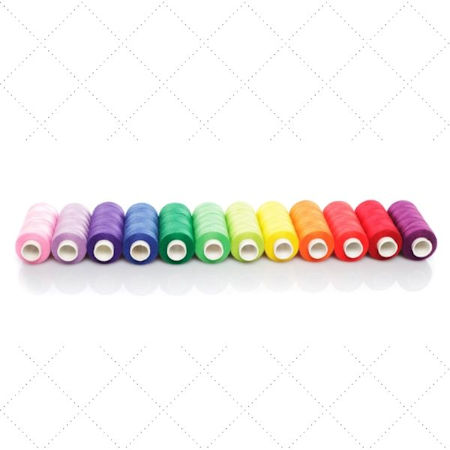Thread Breaking Checklist
Having problems with your embroidery thread breaking?
When this question was posted on our Facebook Group - Sandie Beltran posted this amazingly detailed Check List .
Sandie has very kindly allowed us to post on the Website, so you can all share her tips
Checklist for thread breaking with a few additions:
1) Quality thread? Not too old? Not rayon (Rayon is a beautiful thread, but it takes gentle treatment and does break frequently).
2) Check your needle for snags, sized appropriately, etc. Some threads do better with a top stitch or metallic needle. Sometimes you can get a bum needle. But sometimes the bigger eye of a topstitch needle can cause sloppy stitch formation.
3) Check your stitch plate where the thread goes into the machine to form a stitch. Any snags or rough spots? Since you're going in all directions, the thread can contact a rough spot that hadn't been an issue with regular stitching.
4) Is it directional? Only happen as you stitch backwards? Happens to me sometimes. The needle can actually pierce the working thread (thread takes many passes through the machine before it is finally made into a single stitch, piercing it will break that working thread pretty quickly. Try to limit how much you stitch directly backwards, especially as that's where the needle is most prone to flexing.
5) Thicker, rougher threads, even some quality cottons can be 'grabby' and shred if there's a lot of stitching on top of stitching (backtracking or really dense designs).
6) Sometimes it can be a timing issue- if the top thread seems to be getting split and parts are worked into a few different stitches while a ply isn't getting stitched. The hook is splitting the thread as it’s being formed. Tends to happen on thicker threads or lower ply thread (2 ply vs. 3 ply).
7) Check the upper thread path. Sometimes a slippery thread can flip itself around something as you stitch, work itself out of the take up lever, etc.
8) Are you also having tension issues? A too tight top tension can sometimes cause the thread to break.
9) Check your bobbin case for nicks, scratches, rough spots too. The top thread has to pass around the case in order to form a stitch, so it's got to be smooth and undamaged.
10) Check how the thread is unwinding from the spool.
- If it is a straight-wound spool, it may not like the extra twist it is being given by spooling the thread off the top.
- If it is a slippery thread, it may be getting tangled around the spool pin and/or benefit from a thread net.
I also want to include a few more tips gleaned from working at my Janome dealer's shop part-time.
Make sure you are using the proper bobbin for your machine!
You would be amazed at how many machines we see whose main issue is the wrong bobbin! It's easy to grab the wrong bobbin, especially at a big-box store's sewing section or if you have had multiple machines. The machines may move on, but the accessories and bobbins tend to stay.
I also recommend getting genuine bobbins from your machine's manufacturer.
Ask your dealer if the bobbins you are being sold for your machine came from the manufacturer or if they are generics that fit your machine. There are generic bobbins out there with the same dimensions (or "close-enough"), but I always have less trouble with my Janome bobbins in my Janome machine.
I also like buying the colored bobbins from Janome so I can separate the thread typed in my bobbins. I recently got blue bobbins and they also have pink ones. Take it from me, I buy generic everything most of the time, but not bobbins.
Don't forget to raise your presser foot when threading your machine, so that the thread slides into the tension disks properly.
I also raise my presser foot first when I am changing my top tension.
Note from Heather
Thank you so much for sharing your expertise Sandie - this will help many of us!!


